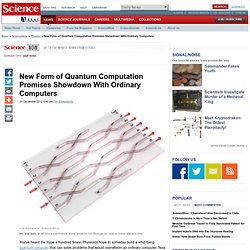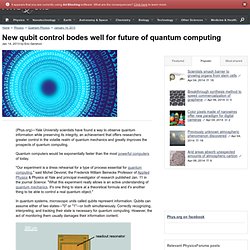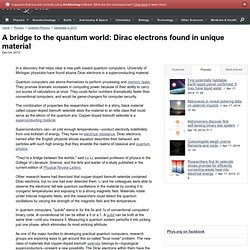

Quantum computer. Study of a model of computation Quantum computing is the use of quantum phenomena such as superposition and entanglement to perform computation.

Computers that perform quantum computations are known as quantum computers.[1]:I-5 Quantum computers are believed to be able to solve certain computational problems, such as integer factorization (which underlies RSA encryption), substantially faster than classical computers. New Form of Quantum Computation Promises Showdown With Ordinary Computers. You've heard the hype a hundred times: Physicists hope to someday build a whiz-bang quantum computer that can solve problems that would overwhelm an ordinary computer.

Now, four separate teams have taken a step toward achieving such "quantum speed-up" by demonstrating a simpler, more limited form of quantum computing that, if it can be improved, might soon give classical computers a run for their money. But don't get your hopes up for a full-fledged quantum computer. The gizmos may not be good for much beyond one particular calculation. Even with the caveats, the challenge of quantum computing has proven so difficult that the new papers are gaining notice.
"The question is, does this give you a first step to doing a hard calculation quantum mechanically, and it looks like it might," says Scott Aaronson, a theoretical computer scientist at the Massachusetts Institute of Technology (MIT) in Cambridge and an author on one of the papers. First, researchers must assemble workable qubits. Information teleportation goes large-scale. Quantum teleportation of information between quantum objects, like photons, is so well-understood that it’s almost routine.

Now, an international physicists is claiming to have carried out the same trick in the macro universe. If the experiment can be replicated, it will be an impressive trick. The scientists, led by Jian-Wei Pen of the University of Science and Technology in Hefei in China, say they’ve teleported quantum state information between ensembles of 100 million rubidium atoms. With a radius of 1 mm across, that’s large enough to be seen with the naked eye. There’s a good reason for wanting to teleport state between macro objects: they stay where they’re put. The information teleported in the experiment was the spin state of the two rubidium atom ensembles, separated by a 150-meter optical cable (although only half a meter apart in the laboratory). The storage lifetime of spin states in the ensembles Pen’s group used was 129 microseconds. New qubit control bodes well for future of quantum computing.
(Phys.org)—Yale University scientists have found a way to observe quantum information while preserving its integrity, an achievement that offers researchers greater control in the volatile realm of quantum mechanics and greatly improves the prospects of quantum computing.

Quantum computers would be exponentially faster than the most powerful computers of today. "Our experiment is a dress rehearsal for a type of process essential for quantum computing," said Michel Devoret, the Frederick William Beinecke Professor of Applied Physics & Physics at Yale and principal investigator of research published Jan. 11 in the journal Science. "What this experiment really allows is an active understanding of quantum mechanics.
It's one thing to stare at a theoretical formula and it's another thing to be able to control a real quantum object. " In quantum systems, microscopic units called qubits represent information. "As long as you know what error process has occurred, you can correct," Devoret said. Quantum networks may be more realistic than we thought. The quantum Internet is a term that has been bandied about a lot recently. And, for the moment it is utter nonsense. The Internet connects computers, so the quantum Internet pre-supposes the existence of useful quantum computers. The Internet also involves arbitrary on-the-fly routing through many intermediate stations, while current quantum communications protocols rely on point-to-point connections. I can't think of anything less Internet-like than that. The nice thing about buzzwords, though, is that some people take them seriously while also recognizing the problems inherent to the idea. Quantum static on your phone line The issue boils down to the very nature of the quantum state.
To expand that range, you need to entangle qubits at distant locations. The process of entangling two photons is, however, not always successful. Spreading your bets on photon survival This would all be so much easier if the quantum state was stored across multiple photons. But wait, it's a router too. A bridge to the quantum world: Dirac electrons found in unique material. In a discovery that helps clear a new path toward quantum computers, University of Michigan physicists have found elusive Dirac electrons in a superconducting material.

Quantum computers use atoms themselves to perform processing and memory tasks. They promise dramatic increases in computing power because of their ability to carry out scores of calculations at once. They could factor numbers dramatically faster than conventional computers, and would be game-changers for computer security. The combination of properties the researchers identified in a shiny, black material called copper-doped bismuth selenide adds the material to an elite class that could serve as the silicon of the quantum era. Copper-doped bismuth selenide is a superconducting material. Superconductors can—at cold enough temperatures—conduct electricity indefinitely from one kickstart of energy.